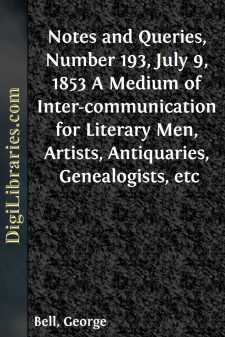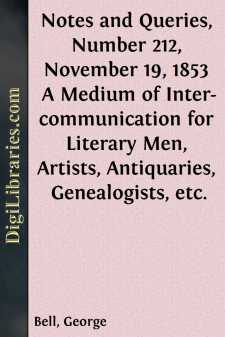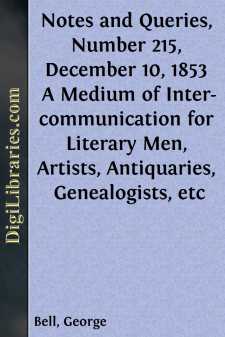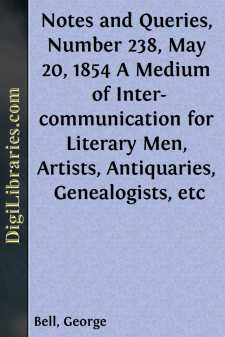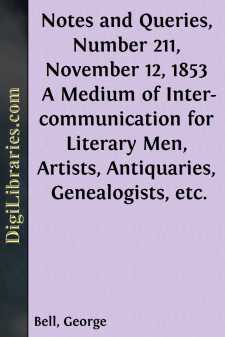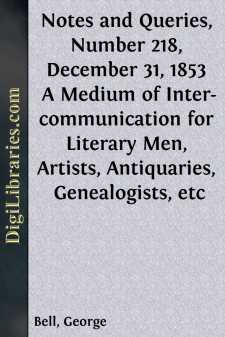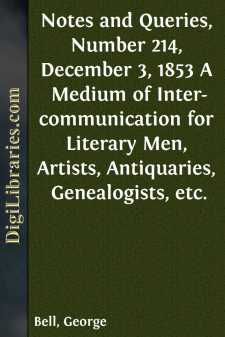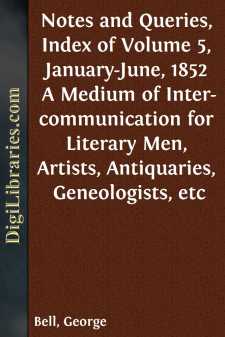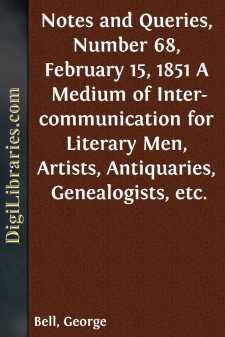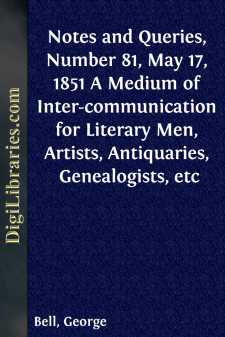Categories
- Antiques & Collectibles 13
- Architecture 36
- Art 48
- Bibles 22
- Biography & Autobiography 813
- Body, Mind & Spirit 142
- Business & Economics 28
- Children's Books 17
- Children's Fiction 14
- Computers 4
- Cooking 94
- Crafts & Hobbies 4
- Drama 346
- Education 46
- Family & Relationships 57
- Fiction 11829
- Games 19
- Gardening 17
- Health & Fitness 34
- History 1377
- House & Home 1
- Humor 147
- Juvenile Fiction 1873
- Juvenile Nonfiction 202
- Language Arts & Disciplines 88
- Law 16
- Literary Collections 686
- Literary Criticism 179
- Mathematics 13
- Medical 41
- Music 40
- Nature 179
- Non-Classifiable 1768
- Performing Arts 7
- Periodicals 1453
- Philosophy 64
- Photography 2
- Poetry 896
- Political Science 203
- Psychology 42
- Reference 154
- Religion 513
- Science 126
- Self-Help 84
- Social Science 81
- Sports & Recreation 34
- Study Aids 3
- Technology & Engineering 59
- Transportation 23
- Travel 463
- True Crime 29
Notes and Queries, Number 193, July 9, 1853 A Medium of Inter-communication for Literary Men, Artists, Antiquaries, Genealogists, etc
by: George Bell
Categories:
Description:
Excerpt
THE EYE: ITS PRIMARY IDEA.
I do not remember to have remarked that any writer notices how uniformly, in almost all languages, the same primary idea has been attached to the eye. This universal consent is the more remarkable, inasmuch as the connexion in question, though of course most appropriate and significant in itself, hardly seems to indicate the most prominent characteristic, or what we should deem to be par excellence the obvious qualities of the eye; in a word, we should scarcely expect a term derived from a physical attribute or property.
The eye is suggestive of life, of divinity, of intellect, piercing acuteness (acies); and again, of truth, of joy, of love: but these seem to have been disregarded, as being mere indistinctive accidents, and the primary idea which, by the common consent of almost all nations, has been thought most properly to symbolise this organ is a spring—fons, πηγá½µ.
Thus, from , fons aquarum et lacrimarum, h. e. oculus. This word however, in its simple form, seems to have almost lost its primary signification, being used most generally in its secondary—oculus. (Old Testament Hebrew version, passim.) In the sense of fons, its derivative is usually substituted.
Precisely the same connexion of ideas is to be found in the Syriac, the Ethiopic, and the Arabic.
Again, in the Greek we find the rarely-used word á½â¬πá½µ, a fountain, or more properly the eye, whence it wells out,—the same form as á½â¬πá½µ, oculus; á½¢ψ, á½âψις, á½âπτομαι. Thus, in St. James his Epistle, cap. iii. 11.: μá½µτι ἡ πηγá½´ á¼Âκ τá¿â ς αá½Âτá¿â ς á½â¬πá¿â ς βρá½»ει τὸ γλυκὺ καὶ τὸ πικρá½¹ν.
In the Welsh, likewise, a parallel case occurs: Llygad, an eye, signifies also the spring from which water flows, as in the same passage of St. James: a ydyw ffynnon o'r un llygad (from one spring or eye) yn rhoi dwfr melus a chwerw?
On arriving at the Teutonic or old German tongue, we find the same connexion still existing: Avg, auga,—oculus; whence ougen ostendere—Gothis augo; and awe, auge, ave, campus ad amnem. (Vid. Schilteri, Thes., vol. iii. ad voc.) And here we cannot help noticing the similarity between these words and the Hebrew , which (as well as the Coptic iaro) means primarily a river or stream from a spring; but, according to Professor Lee, is allied to , light, the enlightenment of the mind, the opening of the eyes; and he adds, "the application of the term to water, as running, translucid, &c., is easy." Here, then, is a similar connexion of ideas with a change in the metaphor.
In the dialects which descended from the Teutonic in the Saxon branch, the connexion between these two distinct objects is also singularly preserved. It is to be found in the Low German, the Friesic, and the Anglo-Saxon. In the latter we have eá, eah, eagor, a welling, flowing stream; eah, ægh, eage, an eye, which might be abundantly illustrated....


